Table of Contents
We’ve uncovered the ultimate showdown between robot and real dogs that’ll blow your mind. Imagine zombie apocalypse survival meets social wingman skills, where AI-powered pups compete with furry friends. Robot dogs bring thermal cameras and precision, while real dogs offer authentic emotion and wild spontaneity. Who wins? It depends. But trust us, this isn’t your typical pet comparison – stick around, and we’ll reveal secrets that’ll make Rover look like last year’s technology.
Who Would Win in a Zombie Apocalypse?
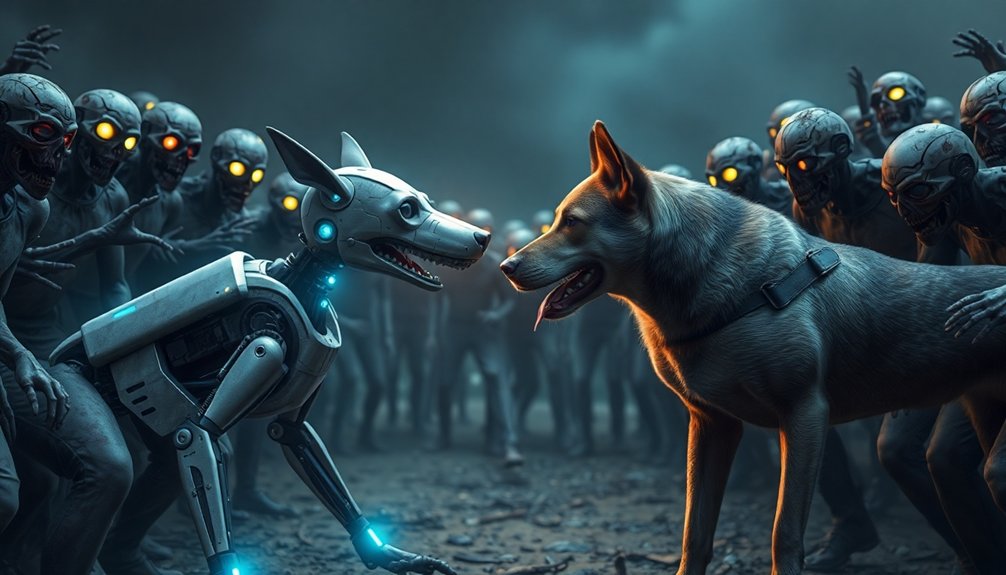
How would our loyal companions fare against the undead horde? When zombies start shuffling, we’ll want more than just cute faces and wagging tails.
Robot dogs might’ve the tactical edge with their advanced zombie detection sensors and potential weapon systems. Their sensor fusion capabilities could provide unprecedented environmental mapping during zombie encounters. But real dogs bring primal survival instincts that algorithms can’t replicate. Their razor-sharp sense of smell could sniff out approaching zombies long before our metal friends even register a blip.
Combat strategies would differ dramatically: robot dogs might neutralize threats with precision, while real dogs could create chaotic diversions or alert human survivors. The amphibious robotic design could provide a unique advantage in navigating diverse zombie-infested terrains that might trap traditional robots. The UTC research team’s robotic control systems could potentially program strategic zombie evasion techniques with unprecedented precision.
Unleash canine chaos: metal precision meets furry survival tactics in the zombie apocalypse.
Sure, robot dogs won’t need food, but they’ll need charging – good luck finding an outlet during the apocalypse.
Ultimately, we’re betting on a hybrid strategy: one part silicon, one part fur, total zombie-fighting power.
Wingman Skills: Picking Up Dates at the Park
Want to turn your four-legged friend into a certified dating wingman? Dogs are social superheroes at the park, where canine behavior becomes your secret matchmaking weapon. According to studies, social dynamics in dog parks reveal complex interaction patterns that can enhance human connections. Robotic companions struggle to replicate the intuitive emotional connections that real dogs naturally create. Research shows that pet social networks increase community interactions, with 40.5% of pet owners making acquaintances through their animals.
Owner interactions follow a predictable script: dogs play, humans chat, sparks potentially fly. Park etiquette matters—a well-behaved pup attracts positive attention faster than any cheesy pickup line.
Social dynamics work magic when your furry friend acts as a conversation starter, breaking ice more effectively than awkward small talk. Less than 2% of dog interactions involve actual aggression, so chances are your potential date won’t run screaming.
Pro tip: Watch your dog’s signals, intervene appropriately during playful moments, and let natural connections happen.
Who knew finding love could be as simple as a walk in the park?
Dance-Off: Silicon vs. Fur
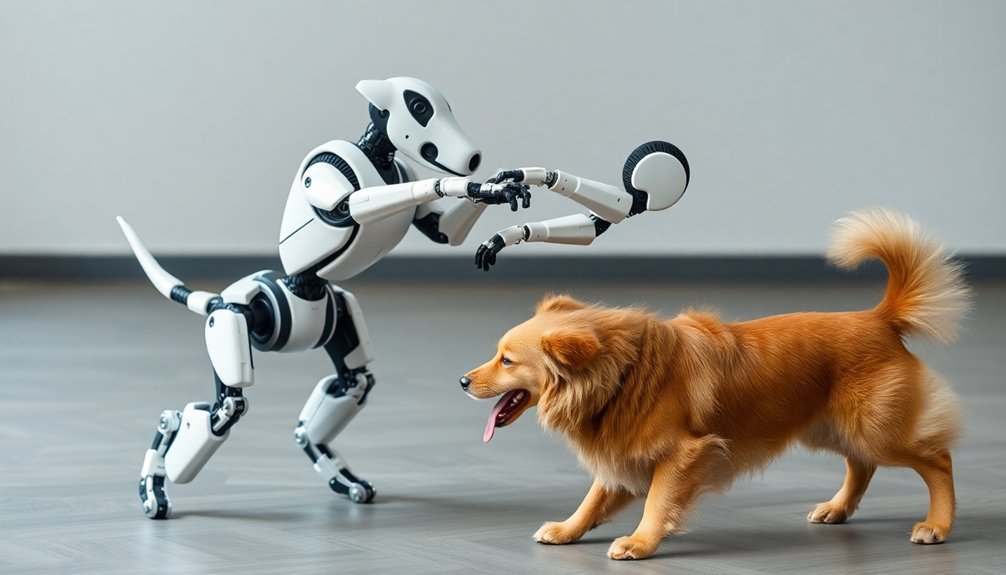
From wingman pups to dance floor champions, the battle between robot and real dogs reveals a hilarious showdown of movement and mechanics.
When it comes to dance choreography, we’ve got two very different performers:
- Robot dogs execute perfectly synchronized moves with LED-enhanced pizzazz
- Real dogs bring movement spontaneity that no algorithm can predict
- Mechanical pups have pre-programmed routines; living dogs have pure joy
- Battery-powered dancers have limits; furry friends dance until they drop
- One uses motors; the other uses pure, unbridled animal spirit
Imagine a dance-off where precision meets passion: robot dogs clicking through calculated steps while real dogs bounce, twist, and spin with wild abandon.
Who wins? Technically the robot might nail every move, but the real dog’s tail-wagging, ear-flopping performance steals our hearts every single time.
Silicon might’ve rhythm, but fur has soul.
Bathroom Habits: Clean vs. Messy
While robots might seem like the pinnacle of cleanliness, when it comes to bathroom habits, real dogs and their mechanical counterparts couldn’t be more different.
Bathroom etiquette looks wildly different: our furry friends leave behind natural waste that requires constant management, while robot pups just… don’t.
Real dogs need training, scheduled breaks, and owners ready with waste bags and sanitizing wipes. Their mechanical doppelgängers? Zero maintenance, zero mess.
We’re talking about creatures that transform waste management from a daily chore into a non-existent concern. Frequency of bowel movements can vary in real dogs, typically ranging from one to two times daily, adding another layer of unpredictability to pet care.
Imagine never scrubbing a floor or carrying a plastic bag on a morning walk. Robot dogs eliminate (pun intended) the entire messy biological process, turning bathroom breaks from a necessity into a nostalgic memory of pet ownership past.
Adult dogs typically require consistent digestive monitoring to ensure their health and well-being, a complexity robot dogs completely avoid.
Netflix Marathon Champions
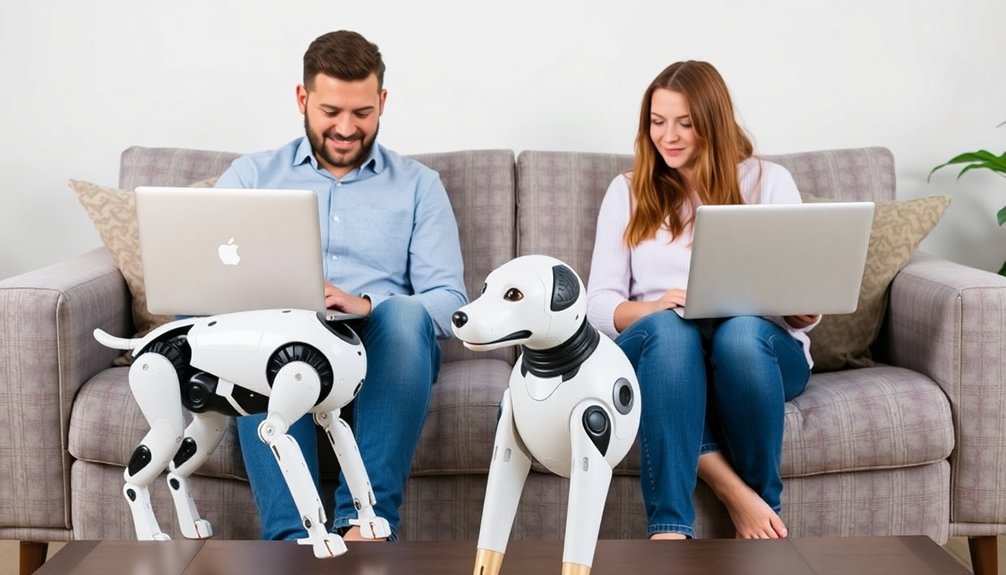
How do you define a true Netflix marathon champion? Let’s break it down with some hardcore streaming intel:
- These are the warriors who clock 3.2 daily video hours like it’s their job.
- They’re the 19% who access Netflix multiple times daily.
- Viewers aged 35-44 are the reigning binge-watching monarchs.
- TVs are their battlefield, with 70% preferring big screens.
- Original content keeps them glued, especially peak-week releases.
We’ve seen the data, and Netflix marathon champions aren’t just passive viewers – they’re strategic content consumers.
They know how to navigate streaming preferences with surgical precision, turning binge-watching from a casual hobby into an art form.
While others casually scroll, these champions are planning their weekend-long content conquests, ready to devour entire series in one gloriously uninterrupted sitting.
Their commitment? Legendary.
The data from “Adolescence” shows that peak viewership can dramatically influence a show’s overall streaming success, revealing the power of strategic content release timing.
Netflix’s dominance in viewership demonstrates that top-tier originals can create an unstoppable audience momentum.
Awkward Family Reunion Survival Guide
We’ve all been there: trapped in mind-numbing family reunion small talk that makes root canals seem like exciting entertainment. Emotional reactions management can be crucial in transforming potentially stressful interactions into bearable experiences. Our survival guide starts with mastering the art of strategic conversation escape—think verbal judo meets social ninja tactics. From deflecting intrusive questions about your love life to creating conversational ejector seats when Uncle Bob starts his political rant, we’ll show you how to navigate family gatherings with the precision of a GPS and the charm of a diplomatic immunity card. Avoiding heated topics can help prevent unnecessary tension, such as steering clear of controversial subjects and maintaining a light, neutral conversational tone at the dinner table.
Dealing With Awkward Small Talk
Ever wondered why family reunions feel like maneuvering through a minefield of cringe-worthy conversations?
Family dynamics can be a complex maze of awkward interactions, but we’ve got engagement strategies to save you from total social meltdown.
Here’s how to survive small talk without losing your mind:
- Prepare interesting conversation topics in advance
- Ask open-ended questions that invite real dialogue
- Listen actively and show genuine curiosity
- Use humor strategically to break tension
- Find common ground that sparks meaningful connection
The secret isn’t avoiding awkwardness—it’s steering through it with grace.
By approaching conversations with curiosity and respect, you’ll transform potential social landmines into opportunities for genuine connection.
Who knows? That uncle you’ve always found intimidating might just surprise you with a fascinating story.
Escape Survival Strategies
Family reunions can feel like emotional obstacle courses, with social landmines waiting to detonate at any moment. We’ve got escape routes and survival gear mapped out for maximum awkwardness avoidance. Check out our strategic retreat plan:
| Escape Method | Difficulty | Risk Level |
|---|---|---|
| Bathroom Hideout | Low | Minimal |
| Outdoor “Emergency” | Medium | Moderate |
| Fake Phone Call | High | Extreme |
When conversations start spiraling toward uncomfortable territory, we recommend strategic repositioning. Scan the room for potential allies, craft clever diversions, and be prepared to pivot faster than a robot dog dodging social interaction. Your primary objectives: maintain dignity, minimize painful small talk, and preserve familial relationships without sacrificing your sanity. Remember, tactical retreat isn’t surrender—it’s strategic self-preservation.
Secret Agent Mode: Stealth and Surveillance
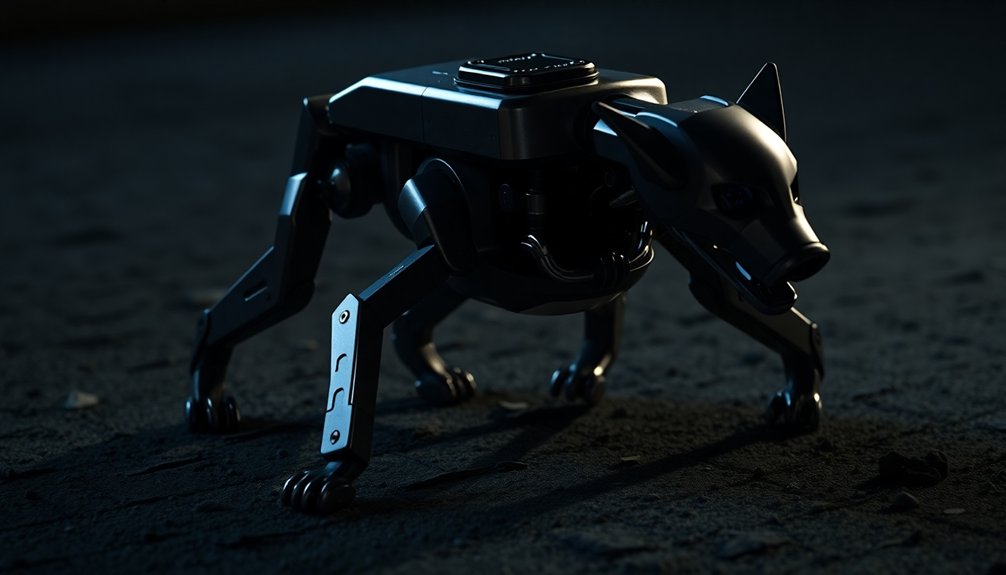
Ever wonder how robot dogs are basically the James Bond of the surveillance world?
These four-legged tech spies can sneak through urban landscapes like digital ninjas, capturing intel that human agents could only dream about.
With stealth capabilities that make traditional reconnaissance look like amateur hour, robot dogs are transforming how we think about intelligence gathering, one silent patrol at a time.
Robotic Reconnaissance Masters
When stealth meets silicon, robot dogs transform from quirky tech demos into modern-day secret agents that make James Bond look like an amateur.
Our robotic reconnaissance troops are rewriting surveillance technology’s rulebook, deploying intelligence that would make CIA operatives jealous.
These four-legged tech marvels bring serious game:
- 360-degree thermal cameras that see through darkness like night vision superpowers
- AI algorithms that predict security breaches before humans even notice
- Silent movement that makes ninja stealth look loud
- Wireless communication networks enabling instant threat coordination
- Ability to access spaces humans and traditional dogs can’t reach
Who needs human agents when these silicon spies can patrol 24/7 without coffee breaks or attitude problems?
The future of surveillance just got four-legged and frighteningly smart. Sensor fusion technologies enable these robotic canines to integrate multiple data streams, creating an unprecedented level of environmental awareness and threat detection.
Stealth Mission Capabilities
Because stealth is the name of the game, robot dogs are about to turn traditional surveillance on its head. We’re talking stealth technology integration that makes James Bond look like an amateur. With sensor advancements that could make a bat’s echolocation seem primitive, these mechanical canines slip through environments like digital ghosts.
| Stealth Feature | Robot Dog Capability |
|---|---|
| Camouflage | Light/thermal absorption |
| Detection | Near-zero noise signature |
| Terrain | Extreme environment adaptation |
| Data Processing | Real-time AI analysis |
Imagine a surveillance tool that doesn’t breathe, doesn’t blink, and processes complex data faster than you can say “covert operation.” These aren’t just machines; they’re the future of intelligence gathering. Who needs a furry four-legged friend when you can have a high-tech reconnaissance master that never gets tired?
Urban Infiltration Tactics
From ghostly sensors to urban stealth missions, robot dogs are about to rewrite the playbook on surveillance. These high-tech guardians are transforming how we monitor urban landscapes with their mind-blowing capabilities.
Their surveillance techniques are seriously impressive:
- 360-degree vision that catches what humans miss
- Thermal imaging that sees through darkness
- Terrain-crushing mobility across impossible spaces
- Real-time data transmission faster than human communication
- AI-powered predictive analytics that anticipate threats
Environmental adaptability is their superpower. Unlike traditional security methods, these robotic canines slip through environments undetected – scaling walls, maneuvering tight spaces, and operating in conditions that would make human guards think twice.
They’re not just machines; they’re the new urban reconnaissance experts, turning city surveillance into a sci-fi reality where every corner, every shadow becomes watchable. Who needs human eyes when robot dogs are on patrol?
Neuromorphic computing enables these robotic systems to process complex environmental data with unprecedented precision and adaptability.
Therapy Session: Emotional Bandwidth Showdown
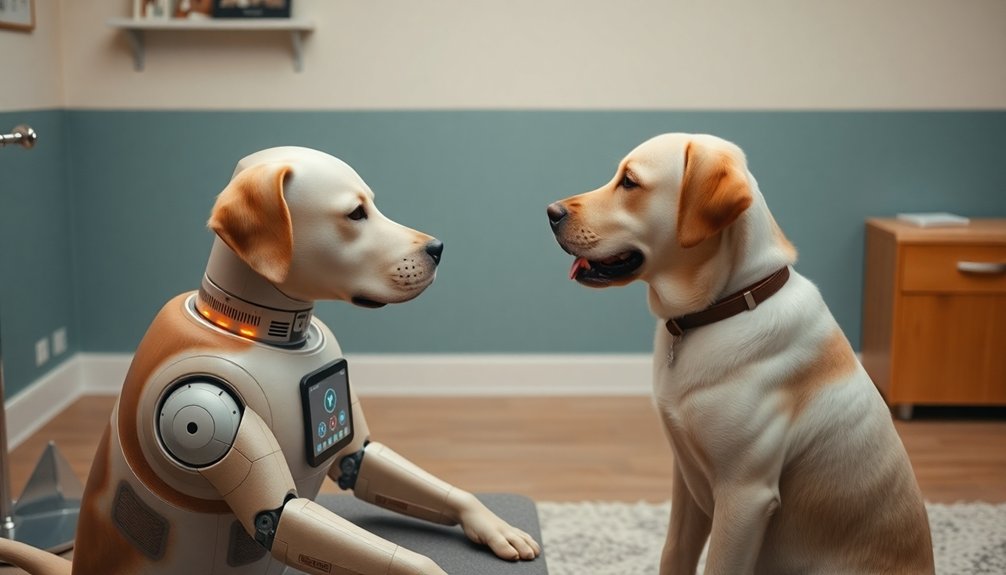
While robot dogs might seem like glorified algorithms in fur-like casings, the emerging landscape of emotional therapy reveals a surprisingly nuanced battlefield between silicon and sentience. These mechanical canines are pushing boundaries in emotional intelligence, offering stress relief through calculated interactions. Sure, they can’t match the raw empathy of a flesh-and-blood pup, but they’re learning fast. Their AI-driven responses mimic companionship with increasing sophistication, adapting to individual emotional landscapes. Real dogs still win on authentic connection—that unconditional love can’t be coded—but robot dogs are closing the gap. They’re not replacements; they’re companions of a different breed. Neuromorphic computing enables these robotic companions to process emotional cues with increasing depth and complexity.
People Also Ask
Can a Robot Dog Actually Replace the Emotional Bond of a Real Dog?
We can’t fully replace the deep emotional connection of a real dog through technology. Authentic companionship value stems from living, breathing, unpredictable relationships that robots simply cannot replicate.
How Much Do Robot Dogs Cost Compared to Adopting a Real Dog?
We’re talking mind-blowing price differences! Robot dog prices range from $15 to $600, while real dog adoption costs vary between $50 and $500, with ongoing expenses making furry friends considerably pricier long-term.
Are Robot Dogs Safe for Children and Elderly People to Interact With?
We’ve found robot dogs offer safe interaction for children and elderly, with advanced sensors preventing accidents and providing engaging companionship without the unpredictability of live animals.
Do Robot Dogs Require Special Maintenance or Technical Skills to Operate?
Like a complex chess piece needing precise positioning, robot dogs demand specialized care. We’ll manage software updates and battery maintenance, requiring technical training and regular servicing to keep our mechanical companion performing smoothly.
Can Robot Dogs Learn and Adapt Like Real Dogs Over Time?
We’ve discovered robot dogs can learn and adapt through advanced AI algorithms, leveraging robot learning and adaptability features that enable rapid skill acquisition via reinforcement and sensor-driven optimization.
The Bottom Line
We’ve explored the bizarre battleground of robot vs. real dogs, and honestly? Technology’s cool, but nothing beats a wet nose and unconditional love. Robot dogs might win at stealth and data processing, but can they genuinely replace the soul-warming magic of a tail wag? Our money’s on fur-powered companions surviving any apocalypse—silicon circuits just can’t compete with pure canine heart.
References
- https://blog.utc.edu/news/2025/03/paws-and-effect-utc-mechatronics-team-training-robot-dogs-to-move-like-canines/
- https://www.nowtolove.com.au/lifestyle/parenting/robot-dogs-to-replace-real-dogs-by-2025-16331/
- https://www.petoi.com/pages/robo-dog-kia-petoi-bittle-spot-mini-mit-cheetah-sony-aibo-robot-dog
- https://cybernews.com/ai-tools/best-ai-robot-pets/
- https://www.sciencedaily.com/releases/2025/05/250508112731.htm
- https://www.bitspacedevelopment.com/exploring-the-potential-of-ai-powered-robot-dogs-in-security-and-surveillance
- https://www.sniffspot.com/blog/sniffspot-community/the-state-of-public-dog-parks-across-the-united-states
- https://www.playcore.com/news/social-and-community-benefits-of-dog-parks
- https://www.psychologytoday.com/us/blog/animal-emotions/202002/let-your-dog-tell-you-if-they-want-go-dog-park
- https://pubmed.ncbi.nlm.nih.gov/29549031/
